|
|
|
Cream of the Crop:
One Woman’s Remarkable Journey in the Free Soviet Jewry Movement.
Part II: Shirley Goldstein: Activist, Humanitarian, Philanthropist
By Leo Adam Biga
EDITOR’S NOTE: In this extended, two-part Jewish Press story, freelance journalist Leo Adam Biga tells the remarkable journey of Omahan Shirley Goldstein in the Free Soviet Jewry movement and how this historic campaign changed her life and is remembered today. Last week in Part One, the story of how this “typical” housewife became politicized and educated in the movement was revealed. This week, discover the lengths Goldstein went to in her human rights activist work and the generosity displayed, then and now, by her and her husband, Leonard “Buddy” Goldstein.
Testing Limits, Courting Danger Continued:
Contacts, Safe Houses and Spy Games
Once swept up in the Free Soviet Jewry movement, Shirley Goldstein set about indoctrinating herself in the tactics of an underground activist. She read, she discussed, she kavetched. She formed Omaha’s Free Soviet Jewry Committee and joined the Union of Council for Soviet Jews. She became a part of an international network whose advocacy and activism sought relief and release for Soviet Jews denied basic human rights.
She learned who to contact among refuseniks, activists and dissidents in the former Soviet Union. She learned where and when it was safe to meet them. In short, she became a secret operative there, much the way a spy is, sneaking information and materials in and out of that oppressive regime.
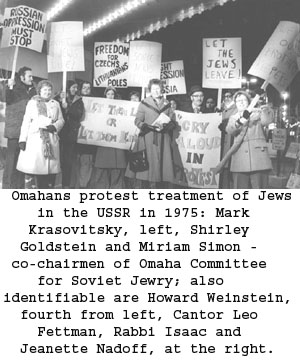
Back home, she made calls, wrote letters, collected and shipped goods, appealed to politicians, etc., all in an attempt to ease the burden and secure the freedom of Soviet Jews. For the few refugees who made it out at first and then for the flood that followed, she helped their resettlement here.
But nothing she did compares to the missions she conducted in the USSR under the guise of “tourist.”
This little Jewish lady carried on her work there despite becoming a person of interest to the KGB. When they tried scaring her off, she simply snubbed her nose at the mighty Soviet state. On a 1973 trip, Shirley and her daughter Gail Raznick went as part of a UNO-sponsored tour.
As Part I explored, Leningrad residents Aba and Ida Taratuta were among the first refuseniks she met. The Taratutas opened their lives and their hearts to her, using their apartment as a meeting place for fellow refuseniks to come and share their stories with Shirley, who faithfully documented it all via tape recorder. These meetings built her circle of contacts and added to the testimonies she collected.
Another key early contact she made, Edward Sorokin, was not a refusenik at all, but sympathetic to Soviet Jews’ plight and to her humanitarian mission. Shirley and Gail met Sorokin by accident in Leningrad. For Goldstein, such contacts were invaluable as she didn’t speak Russian and didn’t yet know her way around.
“He wasn’t even Jewish,” Goldstein said. “Edward and I became very good friends. He helped me on all my trips during the next 15-20 years. He made sure I got places. He was a big source for me. He became friendly with some of my other friends there...helping me if something went wrong. He made phone calls for me. When I got home, I’d send packages and he would see to it they got delivered.”
In Moscow, Shirley and Gail were unsuccessful locating the prominent dissident Vladimir Slepak, but they did meet an English-speaking couple, Galina and Victor Faermark, who soon put them in touch with all the leading Moscow refuseniks and activists. Among these were Benjamin Levich, for whom Victor Faermark served as translator. Levich had been one of the USSR’s most highly decorated scientists before he applied to leave, whereupon he was dismissed from his position and stripped of his medals.
“One of Levich’s boys had been kidnapped off the streets in Moscow and sent to Siberia, just for being Levich’s son,” Goldstein said. “We became very good friends. While we were in Moscow Levich kept giving my name out and it became known, and before I knew it we were meeting Vladimir Slepak. All of them were intertwined. While we were at Slepak’s, people came in and out, including a woman who was a legend, Ida Nudel.”
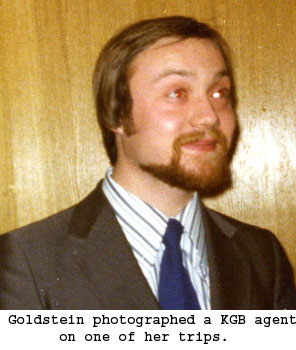
Once back home, Goldstein acceded to a request by Levich. She prepared and shipped care packages, filled with dried foods, for his imprisoned son. She also returned to the States with lists of names of other Soviet Jews in need of various things. She enlisted the help of Russian emigres in Omaha to box the goods. “We shipped out a lot of supplies,” she said. The Goldsteins’ home became a storehouse for hot-ticket items, especially, jeans, large quantities of which she got donated from suppliers she appealed to.
Her return home from that ’73 UNO tour of the USSR was nearly delayed, however, when she was detained at customs in Leningrad. Authorities objected to some posters she carried. It was one of many attempts made to hassle her and discourage her actions. They soon discovered she couldn’t be intimidated.
“I had visited a Jewish day school, whose children made drawings for me to bring back to children here in Omaha. As I went through customs, I carried the posters under my arm when the agents said, ‘Hand it over--you’re taking out important artwork.’ And I said, ‘No, it’s children’s artwork.’ And they said, ‘No, you can’t take them out.’ I argued, ‘But it isn’t anything...’ They wanted my purse, and I said, ‘No,’ and I just held onto those things under my arm.”
She was angry with them.
“Well, the other people in the tour group were saying, ‘Just give it to them...’ But I said, ‘No, it’s not theirs. It has no monetary value. Nothing.’
Well, the Russians still wanted it.”
The plane was held up and she could see either the group was going to leave without her or be stuck there with her, so she told them, “OK, here it is,” and unrolled the posters and tore them up, piece by piece, right in front of the agents. “If I can’t have it, you can’t have it.’ And they said, ‘Pick it up,’ and I walked right by them. When I got on the plane, everybody clapped. ”
“She was defiant,” her daughter Gail said.
Ask Shirley Goldstein if she was afraid, and she tells you, “I was never afraid of them because I knew they wouldn’t touch me. They didn’t want an incident.” “They could harass you though,” Buddy said. To which Shirley adds, “Yeah, they wanted you to know they had the upper hand. But I really felt in command. I really did. Besides, it was ridiculous. All that fuss over nothing.”
Ask Buddy if Shirley’s someone not to trifle with, and he says, “Oh, boy...”
Still, it took some negotiating before she could board the plane with her American tour party. She said Roskens and company flashed enough money and threw around enough names to secure her release.
“Roskens could talk his way out of almost anything,” she said. That’s the way things worked there. “All the way along, if you had the bribes, you could do anything. I’m convinced of that,” she added. “I took cartons of cigarettes with me. You could show a cab driver a pack and go any place. I learned lots of little tricks...”
To avoid hassles, she carried official credentials and letters of recommendation.
“Before leaving for the USSR each time, I’d go to my congressmen and have them write letters of referral for the authorities that said I was seeing people I knew and that the U.S. government would appreciate it if I were not bothered. When KGB or customs agents wanted to see my papers, those letters always came out first.”
To the end, it was a war of wills between her and the apparatchiks. When Goldstein made her last visit to the Soviet Union in 1989 she went with her friend Ruth Potash and then Jewish Press editor Morris Maline. Potash recalled how customs agents confiscated Shirley’s wedgies, even unscrewing the bottoms “to make sure she wasn’t smuggling any tapes in the heels of her shoes. She was on their list. But she was fearless.”
Gail said she and her mother often got crank phone calls in the middle of the night. That didn’t stop Shirley from slipping out of hotels after midnight to meet people. “It was very spy-like. It was like you knew you were being watched but you couldn’t see anybody. I’m amazed by how courageous she was,” Gail said.
“She’s a gutsy lady,” Buddy said of his wife.
In Odessa, another attempt to scare off Goldstein at first angered her and then only emboldened her, but not before she had a good laugh at her own expense.
“I was asleep in my hotel room when I woke up to find a strange man standing inside the door, looking at me. He didn’t say a word. He just wanted me to know somebody was there. Harassing me. I told him to get the hell out. He did. After that, every time I went out of the room I walked backwards and sprinkled baby powder on the floor so I’d know if anybody came in. And, you know what? I was the first person to walk in and mark my own tracks,” she said, laughing at the memory.
Her chutzpah could be inspiring, Laura Bialis, the director of a new documentary film about the movement, Let My People Go, said: “David Selikowitz tells a great story about that. In the ’70s he was a young American living in Paris who’d come to Moscow to drop off some stuff for refuseniks. He and a friend got to the apartment building, but he was scared by all the KGB cars lining the street. He said, ‘I can’t do this.’ The friend said, ‘Well, we’ve come this far, let’s try it.’ So, they go inside and find the apartment, and there’s Shirley Goldstein with Ally Milder...schlepping in all these contraband items.
“And David said to himself, ‘Oh my God, here’s this housewife-grandmother from Omaha, and if she’s not afraid, why should I be?’ She encouraged him to start a French arm of the movement, which he did, and he ended up sending all kinds of people into the Soviet Union. It’s a great image of Shirley,” Bialis said, “because she’s so unassuming and so modest, and yet she did such incredibly brave things.”
Goldstein’s most historic trip to the Soviet Union came in 1975. It was an Omaha World-Herald sponsored tour that, as usual, she used as cover for her activist work or, as she called it, “doing my own thing.” The tour’s hosts were World-Herald reporter Wally Provost and his wife, Irene. Shirley informed Wally what she planned doing and he agreed to tag along with her to a meeting of refuseniks.
“Well, he came with me the first night in Moscow and after that he said, ‘Every time you go see somebody, I want to go.’” Provost found enough material to write a series of articles, one titled Shirley Goldstein Goes to Russia, about the movement and how tough life was for Soviet Jews. “Wally’s series brought the issue to the forefront. It made a lot of difference. I got lots of calls and letters from that. And he and Irene really became dedicated Soviet Jewry activists.”
Another journalist she brought to the movement is former Jewish Press editor Morris Maline, who traveled with her to the USSR. Under his watch, the Press closely covered the Soviet Jewry struggle and local efforts to address it. She even filed occasional reports for the Press from some of her travels.
Also in her own role as a reporter for the movement, she took still pictures of an incident outside a synagogue in which a gathering of Jews were rousted by police. “It opened your eyes as to how they took care of affairs they didn’t want shown to the general public,” she said. Her pics were published around the world.
Sharansky
On that same ’75 trip she was interviewing refuseniks one morning outside a Moscow synagogue closely watched by the KGB, when someone asked her, “Have you met Sharansky?”
“And I answered with the now famous words, ‘Sharansky, who’s he? Never heard of him.’ Well, Anatoly Sharansky was the voice, really, of all the refuseniks. I don’t know why I didn’t recognize his name.”
Shirley wasn’t into it deep enough yet.
“Slepak said, ‘We will be at your hotel at one o’clock. I’ll bring Sharansky.’ So, a group of them came. There must have been 15-16 people in the room,” she recalled. “And there was Sharansky. He was a young guy. Very vocal in meeting with people. I said to him. ‘I want the names at the top of the list for being refused and what’s happening to these people.’ And he went in the bathroom with my tape recorder, closed the door and made a recording.”
That became the famous “bathroom tape,” mentioned in Sharansky’s autobiography, Fear No Evil, in which Shirley is mentioned. He named people, how long they’d been held back and many of the details that weren’t well known in the West.
Naming names, she said, helped ensure refuseniks were afforded better treatment. “If your name became known, Soviet officials knew the West was watching out for you, and so you were likely to have you mail and phone calls go through,” Shirley added.
 Sharansky’s words, widely circulated thanks to Goldstein secreting out the tape, were a kind of state-of-the-union address and call to action for the movement’s followers. Despite painting a bleak picture of the fate of Soviet Jews who dared assert their rights, his message was somehow optimistic and appealed to the international community to apply pressure on the USSR to do the right thing.
Sharansky’s words, widely circulated thanks to Goldstein secreting out the tape, were a kind of state-of-the-union address and call to action for the movement’s followers. Despite painting a bleak picture of the fate of Soviet Jews who dared assert their rights, his message was somehow optimistic and appealed to the international community to apply pressure on the USSR to do the right thing.
Goldstein is proud to have helped make his voice heard.
“I was the first person to bring a tape by Sharansky out. When I returned home, I sent the tape to the Union of Councils headquarters. I didn’t even think to make a copy of it. Look how I trusted the U.S. mail. When it got out I’d carried the tape, I got phone calls from all over.”
By her third trip, she was an expert at bringing banned articles in and out. She knew which American items brought the most on the black market. While she knew a pair of jeans could be sold for enough rubles or bartered for enough food to last a family weeks, she didn’t realize just how vital that exchange was for survival.
“A few years ago a gentleman called us from Canada saying he’s coming through Omaha. He wanted to see Shirley, whom he’d met in Russia,” Buddy said. “We met him and he said to Shirley, ‘I was at your hotel and you gave me two pair of jeans, and those two pair of jeans helped me survive for three years.’”
The chance to impact a person’s life this way is why she continued to help.
“Well, you never want to hear of people suffering. And then seeing them and seeing how it was...and finding out what to do to help them and then doing those things--it was satisfying. When you look back on it, it was a lot of fun.”
The Fruits of Her Labor
Her last visit to the USSR came in 1989. She planned going once more, but by then she’d become such “a nuisance” to the Soviets they revoked her visa. Undaunted, she tried going in with a group of Catholic nuns before being rebuffed. But by then the process she’d been part of to influence Soviet human rights reforms had merged with sweeping changes inside the USSR. “It was public pressure,” she said. “The Soviets hated a bad image and they had one.”
She said when the U.S. and its allies tied future trade deals with the Soviets to their making human rights concessions, the USSR capitulated. For a time. Then tensions mounted and the borders re-closed.
Pressure was applied again as Western leaders decried the USSR’s hard line. In the era of Glasnost, the Soviets finally relented. In the face of government and media denouncements, much of it fed by the movement, the borders reopened and Jews streamed out to stake their freedom.
Shirley helped make it possible. She’s considered a hero in the struggle. So say her fellow activists in the movement and so say refugees whose freedom they feel is, at least in part, due to her work.
Glenn Richter, founder of the Student Struggle for Soviet Jews, considers her “the cream of the cream. We all marveled at her energy, devotion, focus and creativity. God gave her an opportunity to make up for American Jewry’s relative silence during the Holocaust.
Shirley proved one didn't need to be a political big shot, Hollywood star or billionaire to move mountains, he noted.
“She kept and kept at it--the mountains moved, and the Kremlin walls fell.
“I love Shirley. I’m proud of her and I’m proud I’m among one of her friends,” said Lydia Linde, who emigrated in 1990 with her husband Eugene thanks to the Goldsteins sponsoring them. “She’s an absolutely exceptional person. She did very much, not only for our family, but for every family wanting to come here. Shirley met with refuseniks and activists like us, people who believed in the right to be free. That’s why we fought for this. And finally, with her help, we won.
Ann Yuz-Mosenkis agrees. “If you think of the things she was able to do, she definitely could be considered a hero, because she was risking her well-being doing these things and getting the attention of people around the world to what was going on in Russia. Her work definitely helped people in Russia who wanted to be free. It rose a tremendous amount of awareness of how to help, how to fight, how to push governments to change their views,” said Mosenkis, who came to the U.S. with her husband Igor and their two children in 1991.
The story of the movement’s success endures in the lives and in the accounts of people like Richter, Goldstein, Linde and Yuz-Mosenkis. With each passing year, however, the number of surviving activists and refuseniks declines. Thus, there’s an urgency to recording this story for posterity.
That’s what drives the makers of Let My People Go, the new film that tells the story of the movement through the experience of Goldstein and others. It’s also what drives the organizers of an archive, Remember and Save, dedicated to preserving the history of the movement with materials from activists like Goldstein.
Exodus and Resettlement
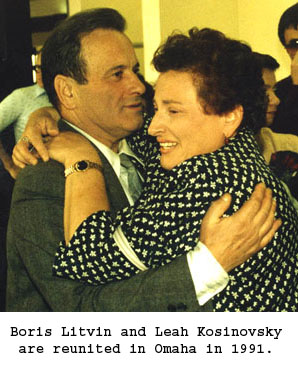
Waging the campaign for the release of Soviet Jews was one thing. Helping sponsor refugees once they came here to start a new life was quite another. Yet Goldstein aided Miriam Simon in leading the Omaha resettlement effort.
From 1971-80, the USSR let tens of thousands of Jews emigrate each year. When tensions with the West increased, the USSR made people pawns by closing emigration to Jews. It wasn’t until the fall of the Soviet Union a decade later that a mass exodus happened. During the migration of the ’70s, when cities across the U.S. were accepting refugees, Goldstein said she and Simon decided, “If we’re going to get them out, we ought to get some here. Miriam was the organizer. I was the instigator. We were like the mothers of the thing.”
The two women secured the support of the Jewish Federation. Jewish Family Service pitched in. Private donations from individuals and businesses like Nebraska Furniture Mart and Borsheims helped. The first families came here in 1975.
“As many families as we said we could take, HIAS would send,” Simon said. “In the beginning, the families that came had no relatives here. They didn’t know a soul. They couldn’t find us on a map.”
Before they came, the committee got them furnished housing. They met each family at the airport with flowers, gifts and welcome signs. Once settled, they helped them get jobs and arranged for them to learn English.
“We did all the things you have to do to bring someone from a totally different culture and make them American. It was a very exciting time, and Shirley helped with all that. Then, as families made lives for themselves, they started bringing over relatives,” Simon added.
“Anytime somebody came or anytime there was a problem, we had it. We did everything we could for them. We really worked hard. It was an exciting time. The Federation’s done a great job resettling them, too,” Goldstein said. “We’ve had such good rapport with refugees. I’ve been to their weddings and funerals and birthdays and graduations...So many have been successful in their careers and in the community, and now their kids are winning scholarships. It’s been great.”
Simon said refuseniks hold Goldstein in high regard because she not only worked to free them but was always there for them after they arrived. She’s been called “an angel” to Omaha’s Soviet Jews.
“Whatever happened to anybody here, Shirley came to help,” said Lydia Linde. “She was very good and friendly and helped us a lot,” said Mosenkis. Well known for doing special things, Shirley’s donated money for the Kripke Library’s Russian-language section that Linde heads, and she ensured pianist Yuz-Mosenkis got a piano of her own after she and her family came.
“They needed help and she responded,” said Simon. “She was committed to doing what she believed was the right thing to do. She never got tired of doing it. She didn’t give up. She didn’t abandon it and go onto the next thing. And she’s that way with everything. If it’s important, well then it’s important. This became her life. At times some of her friends thought she got carried away, and she really didn’t give a darn what they thought.”
As more refugees began leaving the USSR, the resettlement effort needed more funding, and the Operation Exodus drive led by Tom Fellman and Jay Lerner raised more than a million dollars.
A Giving Nature
Friends note Shirley and Buddy have continued taking up what Simon calls “wonderful causes,” adding, “She and Buddy are always sponsoring something.”
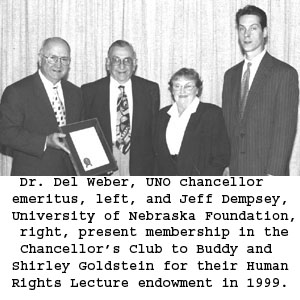 In 1999 the couple endowed the Shirley and Leonard Goldstein Lecture on Human Rights series at UNO, which annually features presentations on emerging human rights issues. They provided seed money for the documentary Let My People Go. They’ve supported Israeli resettlement efforts. They support the Jewish Historical Society, the Kripke Library and countless other things.
In 1999 the couple endowed the Shirley and Leonard Goldstein Lecture on Human Rights series at UNO, which annually features presentations on emerging human rights issues. They provided seed money for the documentary Let My People Go. They’ve supported Israeli resettlement efforts. They support the Jewish Historical Society, the Kripke Library and countless other things.
Their contributions have been recognized. In the 1980s Shirley won the Jewish Federation’s Humanitarian of the Year Award. In 1996 she received an honorary doctor of humane letters from UNO “for her tireless efforts on behalf of Soviet Jewry and the cause of human rights worldwide, for her conviction and example that one person can make a difference in the lives of others, and for her ability to inspire compassion and humanity, both near and far.”
She’s also been honored by the Union of Councils for Soviet Jewry and the National Conference of Christians and Jews. In 2005, the couple received the My Brother’s Keeper Award from Chabad of Nebraska.
“If you know somebody who needs help, you call Shirley and she figures out ways to help,” said Ruth Potash. “I teach English as a second language to adult immigrants. I called her with a problem one of my students was having trying to get his wife here from Syria. I asked Shirley, ‘What can I do?’ She said, ‘We’ll go see Congressman Lee Terry (R-NE).’”
She’s willing to help with anything. She has all these contacts. And she’s very direct. She tells you exactly what’s on her mind and what she wants done. And she accomplishes it. “She’s not namby-pamby,” Potash said. “I think Buddy deserves a lot of praise, too. He supports her. They’re definitely a team.”
Goldstein acknowledges she couldn’t do all she’s done without the support of her husband Buddy and children.
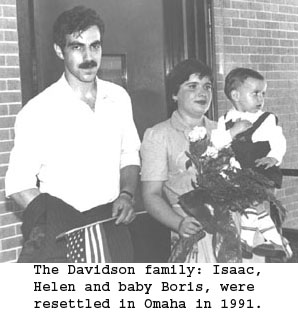 “It wasn’t just me doing this alone. I had a good family that stayed behind me. They’ve always been there for me.”
“It wasn’t just me doing this alone. I had a good family that stayed behind me. They’ve always been there for me.”
Her work for the movement and for other causes has been all about the journey.
“I’ve made wonderful friends I still have today,” she said. “It’s been a great period of my life. Everybody’s got their thing. This is my thing. I’m not a card player. I’m not a golfer. I’ve had a great time.”
Like any giver, her life’s been enriched for her generosity.
“I’ve traveled places I never would have gone to. I’ve seen how Washington works. I’ve seen how Israeli politics work. I have friends in Europe and Israel and here in the States I never would have otherwise. I can go anywhere in the world and see friends.”
Goldstein’s seen the families brought in. She’s seen them resettled. She’s seen their children grow and their accomplishments.
“It’s been a wonderful part of my life and I can’t imagine having done anything else. I’m pleased I was a part of the movement, and that I did not sit by and not do anything about it. I hope it doesn’t happen again to the Jewish people.”
She reminds us anyone can make a difference. It starts with taking an interest and then acting on it.
“Anybody that does any reading can always find something good to work on.”
Preserving the Past
As a veteran of the Free Soviet Jewry movement, Shirley Goldstein supports the preservation of that campaign’s historic achievements. Recently, she donated hundreds of personal documents and photographs related to her own actions in the movement to the Haifa, Israel-based archival project, “Remember and Save: An Archive of the Jewish Aliya Movement in the USSR.” She also serves as honorary president of the non-profit archive, whose executive director is her old friend, Aba Taratuta, one of the first refuseniks she met in the former Soviet Union.
In their efforts to save artifacts, documents, testimonials and narratives of the movement, Taratuta and his staff are in a battle against time. Many activists in the movement have died. Important memoirs, letters and photographs may disappear unless care is taken to place them in this or other archives.
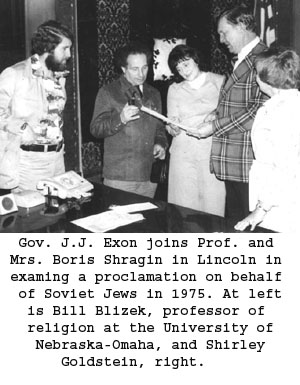 Remember and Save is operated by volunteers, including many former activists from around the world. Established in April 2002, the organization has gathered thousands of documents, photographs, memoirs, books and other materials from more than 150 private archives of former participants in the movement. It has also recorded dozens of detailed audio-interviews with former activists.
Remember and Save is operated by volunteers, including many former activists from around the world. Established in April 2002, the organization has gathered thousands of documents, photographs, memoirs, books and other materials from more than 150 private archives of former participants in the movement. It has also recorded dozens of detailed audio-interviews with former activists.
The organization has plans to: open its archive to journalists, authors, educators and scholars engaged in historical research; publish, and assist in the publication of its archived documents and memoirs; and organize meetings and conferences of former aliya activists with Israeli students and Jewish organizations in Russia.
Remember and Save is also curating an exhibition, “The Jews of Struggle: The Refusenik Movement in the USSR, 1967-1989,” scheduled to open at the Diaspora Museum in Tel-Aviv, Israel in the spring of 2007. The exhibit will commemorate the 40th Anniversary of the movement.
The opening of the exhibition will be accompanied by an international conference on the subject organized by the Hebrew University in Jerusalem.
The Honorary Board of Remember and Save includes former Soviet Jewish activists, as well as leaders of the movement in the West and in Israel. Among them are former political prisoners Vladimir Slepak and Joseph Mendelevich; British historian Sir Martin Gilbert, Israeli scientist Yuval Ne’eman and leaders of Western Jewish organizations.
Remember and Save wishes to hear from anyone who can help in its efforts to locate information about relevant publications and materials, and assist in saving and preserving valuable documents for future generations.
The organization is also seeking financial assistance to support its work. U.S. tax deductible contributions of at least $25 may be sent (and must be made payable) to: P.E.F. Israel Endowment Funds, Inc., 317 Madison Ave., Suite 607, New York, NY 10017, with a recommendation it be used for the archive’s preservation purposes. For more information, check out the ‘Remember and Save’ website at http://www.soviet-jews-exodus.com
The article was published in the Internet newspaper of the Jewish Federation of Omaha, http://jewishomaha.org/content_display.html?ArticleID=179347
|